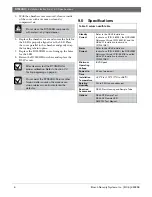
D7050DH
|
Installation Instructions | 6.0 Programming
4
Bosch Security Systems, Inc. | 9/06 | 49325E
6.0
Programming
For multiplex programming, refer to the
D7024 FACP
Operation and Installation Guide
(P/N: 31499)
or the
DS9400M Reference Guide
(P/N: 44578).
7.0 Testing
Test detection devices immediately after installation.
Test the D7050DH according to NFPA Chapter 7-1.6.2
(1999) or more often as required by local code.
7.1 Operational
Testing
Notify all concerned parties before and
after completing maintenance on or testing
the
fire alarm system.
1.
Apply power to the system and check for alarms.
2.
If a D7050DH is in alarm, shut down the system.
3.
Remove the D7050DH and recheck for proper
wiring. If the problems persist, replace the affected
D7050DH or exchange it with a known good
detector. This determines if the problem is caused
by the D7050DH.
4.
When the system is free of alarms, check each
D7050DH to ensure the red LED indicator on the
head flashes. This confirms the detector is
operating properly.
5.
Test each D7050DH to ensure it causes a control
panel alarm.
6.
Alarm the D7050DH by doing one of the
following:
a.
Place a magnet horizontally against the recess
in the duct cover, centering it over the “T”
marked on the head to activate an internal
reed switch.
b.
Remove the duct cover and use a UL Listed
aerosol smoke detector tester such as the
Home Safeguard Industries’ 25S to simulate
an alarm. Follow the instructions included in
the aerosol smoke detector tester.
7.
When a D7050DH alarms, the red LED indicator
on the head flashes at least once per second. Clear
the alarm by initiating a system reset before
proceeding to the next detector.
7.2 Sensitivity
Testing
Calibration is important in determining a
detector’s continued operation. Depending
on local regulations, calibration testing
might be required more than once a year.
According to NFPA72, perform a
Calibration Test at installation and every
other year thereafter. Perform a Functional
Test monthly.
Test the D7050DH’s sensitivity to meet NFPA 72
requirements by conducting a Magnet Test (refer to
Section 7.3 Magnet Test
). You can also test sensitivity by
measuring the calibration voltage pins with D1005 Test
Cable, D344-RL, or D344-RT (refer to
Section 7.4
Voltage Measurement Test
). Calibration can be quickly
determined by visually inspecting the D7050DH’s LED
(refer to
Section 7.2.2 Visual Check
). These tests confirm
whether or not the detector is within its factory marked
calibration range.
7.2.1 Sensitivity
Test
The control panel constantly monitors the D7050DH.
If the detector exceeds the limits of the sensitivity
thresholds, the control panel reports the detector in
question and generates a fault condition.
7.2.2 Visual
Check
The D7050DH includes the Chamber Check
Automatic Trouble Indication that allows it to
automatically show if its calibration is out of the
factory-listed range. You can meet the NFPA guidelines
for sensitivity testing by visually inspecting the
D7050DH and checking the Alarm LED flash rate.
If the calibration is out of range during power up or
longer than 24 h, the Alarm LED double flashes. This
LED single flashes when the detector is operating
normally.
Visually check all detectors before
disconnecting the multiplex bus.
Disconnecting the bus erases the
calibration indication. If the detector was
disconnected or the control panel lost
power within the
last 24 h, perform a Magnet Test or Voltage
Measurement Test to confirm sensitivity.


























